Abstract
Aerosols and primary biological aerosol particles (PBAPs) play an important role in regulating the global climate, but information summarizing the available knowledge is limited. Here, we present a systematic review of in situ studies performed in the last 35 years on aerosols–PBAPs in Brazil, with 212 studies encompassing 474 cases. The Amazon rainforest was the most studied biome, represented by 72% of cases, followed by the Atlantic Forest with 18%. Studies focusing the Amazon mostly investigated climate-related issues and aerosol physics, with less than 5% examining the biological identity of aerosols, whereas outside the Amazon, this number reached 16%. Whilst more than half of the cases within Amazon (55%) were held at seven sampling sites only, conclusions were mainly extrapolated to the entire biome. Contrarily, research beyond the Amazon has mostly addressed the temporal and biological characterisation of PBAPs, and not only is it scattered, but also scarce. Regarding sampling efforts, most cases (72%) had fewer than 100 days of sampling, and 60% of them spanned less than half a year of study. We argue that scientists should produce more detailed/complete assessments of aerosols–PBAPs in Brazil as a whole, particularly considering their biological identity, given their importance to global climate regulation.
1. Introduction
Aerosols—and recently, also primary biological aerosol particles (hereafter, PBAPs)—have been of increasing interest due to their importance in regulating the climate [1]. PBAPs such as bacteria, fungal spores, and pollen, as well as fragments of plants and animals, are thought to affect local and regional climates, in particular through their indirect effects on cloud formation and lifetime [2,3]. The concentration and properties of aerosols–PBAPs largely depend on local (in situ) conditions and land-use and land-cover patterns, which impact their formation and emission rates [4,5]. Consequently, any changes associated with land use might impact aerosols–PBAPs, therefore having knock-on effects on the local climate, with potential consequences for the regional and global climate [6].
In Brazil, the Amazonian region has been receiving increasing interest during the past few decades due to its importance to global climate regulation as well as the opportunity to study aerosols under nearly pristine conditions [7,8]. The rainforest has been threatened by deforestation for many years and is losing its resilience, which will have implications for aerosols–PBAPs and the global climate [9]. Because of this, many projects focusing on aerosols and climate have been carried out in the Amazon rainforest [10,11,12,13,14,15,16]. Amongst these projects, the “Amazon Boundary Layer Experiment”, the “Anglo-Brazilian Amazonian Climate Observation Study”, the “Aerosol, Cloud, Precipitation, and Radiation Interaction and Dynamics of Convective Cloud System”, the “Amazonian Aerosol Characterization Experiment”, the “Global Tropospheric Experiment”, the “Green Ocean Amazon”, and the “Large-Scale Biosphere-Atmosphere Experiment in Amazonia” stand out.
Whilst the Amazonian Forest biome occupies an area of nearly half of the country (i.e., 4.2 million km2), Brazil has five other biomes that are equally as important and diverse [17]. Nevertheless, research focusing on how aerosols regulate the climate in the rest of the country is rare. For example, even though the Brazilian Atlantic Forest is one of the global biodiversity hotspots and where most of Brazil’s population is located, little is understood about aerosol–PBAP emissions over this biome and their climatic impacts [18,19,20]. Of great concern is that the Brazilian Atlantic Forest suffers from a high level of degradation, which weakens the full development of studies due to the loss of biological information [21]. Consequently, there are many research questions that could be explored in the rest of Brazil, for instance, which research aspects need to be developed in the country. Although the remnant part of Brazil might impact global climate regulation as much as the Amazonian region does, the other biomes are not given the same importance and attention that the Amazonian Forest attracts. Thus, to assess the skew of the literature concerning the state of the art of in situ aerosol–PBAP research in Brazil and identify gaps that could be explored in the future, we have performed a systematic review of the literature, investigating published work on this topic spanning 35 years of research. For that, we focused on observational studies with data collected in situ within Brazil and analysed how research on aerosols–PBAPs have exploited the native habitats of the country, summarizing the available information, and indicating directions for future research.
2. Materials and Methods
To comprehensively assess in situ research focusing on aerosols–PBAPs in Brazil, we performed a systematic review of the literature from the date of publication of first paper we found discussing aerosols in the country [22] up to 31 December 2021, using Google Scholar and Web of Science library databases. Particularly, we looked for small phrases or keywords on the terms mostly related to aerosol and PBAP research, such as “aerosol”, “airborne”, “bioaerosol”, “biogenic”, “ice nucle*”, “INA”, “particles”, “PBAP”, OR “primary biological aerosol particles”, AND the biological identity of PBAPs, for instance, “Ascomyc*”, “Aspergillus”, “bacteri*”, “Basiodiomyc*”, “Cladosporium”, “Deuteromyc*”, “fung*”, “Fusarium”, “Penicillium”, “pollen”, “Pseudomonas” OR “spore”. We also searched for environmental words/topics related to aerosol research, for example, “cloud”, “CNN”, “condensation”, “emissions”, “fog”, “fluxes”, “graupel”, “hail”, “haze”, “precipitation”, “rain”, OR “snow”. Information regarding projects that are/were internationally recognised in aerosol research in Brazil, such as “ABLE 2*”, “Amazon Boundary Layer Experiment”, “ABRACOS”, “Anglo-Brazilian Amazonian Climate Observation Study”, “ACRIDICON-CHUVA”, “Aerosol, Cloud, Precipitation, and Radiation Interaction and Dynamics of Convective Cloud System”, “AMAZE-08”, “Amazonian Aerosol Characterization Experiment”, “ATTO”, “Amazon Tall Tower Observatory”, “GTE”, “Global Tropospheric Experiment”, “GoAmazon”, “Green Ocean Amazon”, “LBA”, OR “Large-Scale Biosphere-Atmosphere Experiment in Amazonia”, was also retrieved in combination with the other mentioned terms. We also retrieved studies by searching specifically for biomes and regions within Brazil, for instance, “Amazon*”, “Atlantic Forest”, “Brazil”, “Caatinga”, “Cerrado”, “Pampa” OR “Pantanal”. Figure 1 presents a diagram indicating the keywords and/or small phrases used during the systematic review.
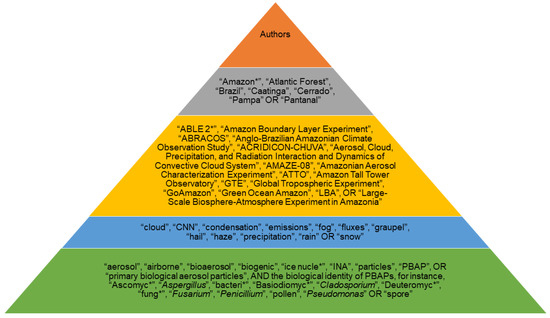
Figure 1.
Diagram indicating the keywords and/or small phrases used during the systematic review of the literature on in situ aerosol–PBAP research in Brazil distributed by year of publication, from 1986 until 31 December 2021.
We have also looked for publications by authors/groups associated with work on aerosols–PBAPs in Brazil. We included only studies performed within Brazil, as well as only studies that examined aerosols in situ. Data from global studies were used when such studies necessarily presented data collected locally (i.e., in situ) in Brazil, and for that, we used the data that referred only to Brazil. Additionally, we scrutinized the bibliography of all papers that were retrieved using these criteria to look for additional studies.
We are aware of the importance of remote sensing and/or modelling studies, given that they help us to understand climate in a broader scale. Nonetheless, studies using remote sensing techniques were excluded from this review, as were previous literature reviews and/or opinion articles on aerosols–PBAPs in Brazil. Purely modelling studies were also removed from the analysis. We have intentionally excluded any papers that did not have in situ data since not only we wanted to focus our attention at observational studies, but mainly because this would introduce a bias in the analysis. If we had incorporated papers that were purely modelling and/or remote sensing studies, they would, beforehand, not have the same ability to determine the biological identity of aerosols–PBAPs as investigations conducted in the ground. This would make them inappropriate to compare with studies that did, since their approach is rather different than in situ studies, hence our option to exclude such studies from our analysis.
After identifying a paper of interest, we used searching tools to look for authors, journal, the year of publication, the biomes/regions/states where the study was carried out, the locale/city of sampling, the site/tower name of sampling locale, the equipment/technique employed, the size of studied particles, the biological identity of the PBAPs, the number of sampling days, and the sampling period (length of study). When the same study presented results for different biomes/regions/states within Brazil, we considered each of those as an isolated case, and otherwise, as a single case. Additionally, if studies presented different techniques, even for the same sampling region/site, we considered each technique as one case. If studies did not explicitly mention the size of particles researched, we derived such information from figures and/or pictures, or from the literature in the case of bacteria/fungi. Moreover, if the identity of PBAPs was not provided (e.g., species, genus, taxon), an “Undifferentiated” term was assigned. If the authors studied both indoor and outdoor environments, we considered data from the outdoor analysis only.
To obtain a proper basis for comparison between the different approaches and fields of research, we also estimated an index of “Sampling Effort” [23]. For this, the number of days in which the data were collected was multiplied by the length of the study. If authors researched for an entire year (i.e., 365 days), the length of study was classified as “1”. Thus, if authors collected aerosols–PBAPs one day per month in a whole year, the sampling effort was considered as 12 (i.e., 1 day × 12 months × 1 year = 12). Whenever information on days of sampling and/or length of study was not directly reported in the text of the retrieved papers, we tried to estimate them based on the figures, graphs, and tables. However, if this was also not possible, we contacted the authors, and if no answer was provided, we assumed the number of days sampled to be equal as one. If the length of the study was not explicitly mentioned and could not be derived from any figures, graphs, and tables presented in the papers, we assumed it to be equal to the number of sampling days. If authors performed their sampling per ‘seasons’ (i.e., spring, summer, autumn, winter) and did not specify their length, we accounted each season to be equivalent to 90 days. Thus, if a paper reported sampling during the seasons of summer and winter, we considered this as equal to 180 days. In all cases, numbers were rounded.
3. Results
3.1. Bibliometric Information
A total of 212 studies distributed into 474 cases met the selection criteria and were, therefore, analysed in this study (Figure 2). A compendium of all 212 studies can be found in Supplementary Table S1. Most cases (193 or 41%) were performed during the decade of 2010–2019, followed by the years between 2000–2009 with 36% of cases (171; Figure 2). Regarding the journal, three international non-Brazilian journals published up to 65% of all cases analysed (a total of 307 cases or 119 studies). The major journal where one-third of all cases/studies on aerosols–PBAPs in Brazil were published was Atmospheric Chemistry and Physics.
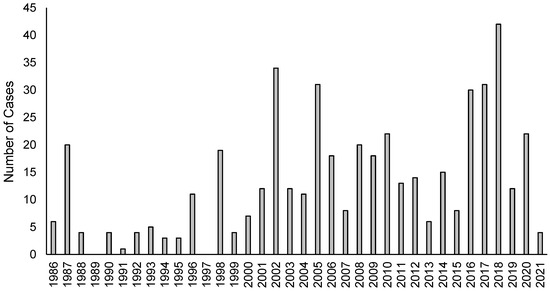
Figure 2.
Total number of cases retrieved in our systematic review of the literature on in situ aerosol–PBAP research in Brazil distributed by year of publication, from 1986 until 31 December 2021.
3.2. Distribution of Cases by Biomes and Sampling Sites
The Amazon rainforest was the biome that was studied in most (72% or 341) cases (Figure 3 and Figure 4A). The Atlantic Forest ranked second, with 18% of all cases (83), and Pantanal was the least researched biome, with only 1 case. Within the Amazon, 187 cases (55% of Amazonian cases) were distributed into seven sampling sites (Figure 4B): (i) “Reserva Biológica do Cuieiras” (15%); (ii) “Fazenda Nossa Senhora Aparecida” (10%); (iii) ATTO (9%); (iv) T3 (8%); (v) “Balbina” (5%); (vi) “Reserva Biológica do Jarú” (5%); and (vii) “Reserva Florestal Adolpho Ducke” (3%). The rest of the Amazonian cases did not specifically report the location where the study was performed. Beyond the Amazonian Forest, the University of São Paulo was the only place with a remarkable data sample, gathering 13% of cases outside that biome.
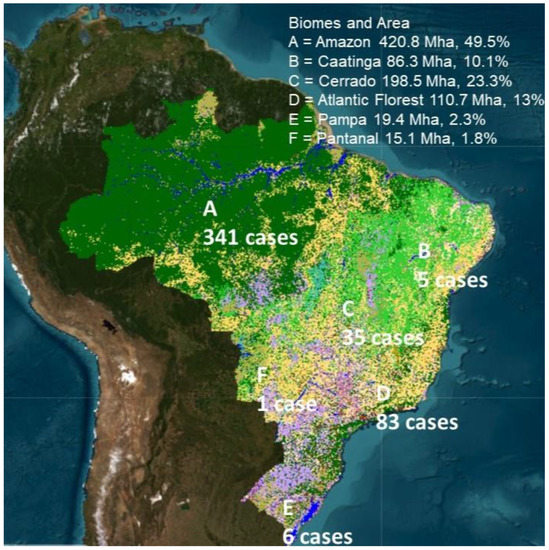
Figure 3.
Map of Brazilian biomes containing the total number of cases retrieved in our systematic review of the literature on in situ aerosol–PBAP research built using the MapBiomes project (available at: mapbiomas.org, as per [17]).
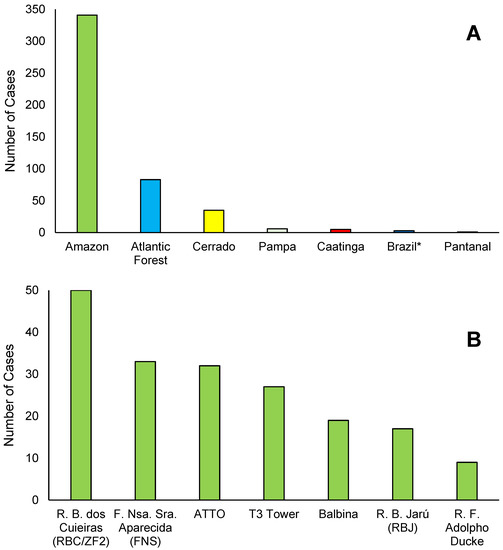
Figure 4.
Total number of cases retrieved in our systematic review of the literature on in situ aerosol–PBAP research in Brazil distributed by Brazilian biomes (A) and total number of cases carried out within the Amazonian biome distributed by high-interest sites (B). Legend: “Reserva Biológica do Cuieiras”; “Fazenda Nossa Senhora Aparecida”; ATTO, Amazon Tall Tower Observatory; T3 Tower; “Balbina”; “Reserva Biológica do Jarú”; and “Reserva Florestal Adolpho Ducke”. Note: * refers to studies that were performed using airplanes spanning an area bigger than only one biome.
3.3. Aerosol–PBAP Sampling and Characterisation
The majority of cases used stacked filter units (SFUs) to collect aerosols in Brazil, with a total of 107 (23%). Other techniques/equipment used included the micro-orifice uniform deposition impactor (MOUDI), condensation particle counters (CPCs), nephelometers, etc. Regarding the size of particles, most cases (173 or 37%) focused the research on both PM2.5 (fine) and PM10 (coarse-mode) aerosols (Figure 5). A total of 143 cases (30%) investigated submicron (i.e., <1 µm) particles only, 44 cases (9%) researched only fine-mode (PM2.5), and the remnant 114 cases (24%) studied several sizes. Only 37 out of 474 cases (8%) investigated the biological identity of the particles (Figure 6). For studies performed outside of the Amazonian region, 16% of all cases examined biological properties of aerosols, whereas within the Amazon, this was carried out in less than 5% of cases.
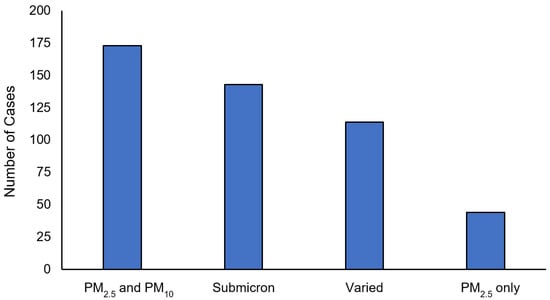
Figure 5.
Total number of cases retrieved in our systematic review of the literature on in situ aerosol–PBAP research in Brazil distributed by size (µm) of particles investigated. Legend: PM2.5 and PM10 refers to the cases that investigated both PM2.5 (fine; <2.5 µm) and PM10 (coarse-mode; <10 µm) aerosols; submicron refers to the cases that examined only particles <1 µm; varied refers to the cases that studied different sizes of particles (i.e., 0–2000 µm); and PM2.5 only refers to the cases that researched fine-mode aerosols only (i.e., <2.5 µm).
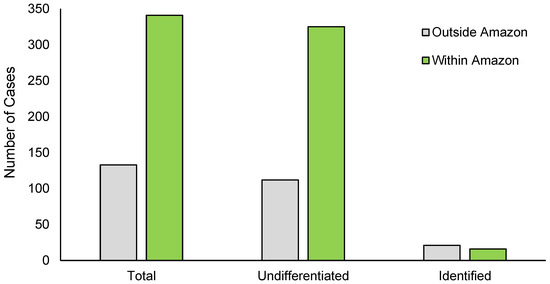
Figure 6.
Total number of cases retrieved in our systematic review of the literature on in situ aerosol–PBAP research in Brazil distributed by their biological identification. Legend: “Undifferentiated” refers to the cases that did not examine the biological identity of aerosols–PBAPs; “Identified” refers to the cases that examined the biological identity of aerosols–PBAPs; “Outside Amazon” refers to the cases carried out in areas outside the Amazonian region of Brazil; “Within Amazon” refers to the cases performed within the limits of the Brazilian Amazon.
3.4. Sampling Effort of Aerosol–PBAP Research
Regarding the sampling effort, most cases (72%) had less than 100 days of sampling, and in 35% of cases (163), there were 30 or fewer days of sampling (Figure 7A). Only 13% (62 cases) reported more than 365 days of sampling. Considering the time spanned in research, 60% of all cases (287) were shorter than half a year (Figure 7B), confining research to one or two seasons at the most. Consequently, the estimated sampling effort index (i.e., number of days sampled by the length of study) was very low (Figure 7C).
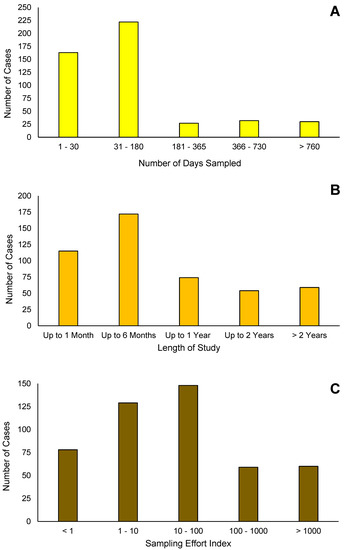
Figure 7.
Total number of cases retrieved in our systematic review of the literature on in situ aerosol–PBAP research in Brazil distributed by (A) number of days sampled, (B) length of study, and (C) sampling effort index. Note: the sampling effort index was calculated by multiplying the number of days in which the data were collected by the length of the study (as per [23]; see Materials and Methods).
4. Discussion
The results of our systematic literature review concerning in situ aerosol–PBAP research in Brazil elucidate the state of the art from 35 years of research and identify gaps that should be explored in the future. Certainly, most studies were performed via international projects that occurred during the years 2000–2019, such as “ACRIDICON-CHUVA”, “AMAZE-08”, “GoAmazon”, and “LBA” [13,14,15,16]. This suggests that without both intellectual and financial external contribution and partnerships from outside of Brazil and, in particular, from the USA and Europe, aerosol research within the country would be confined to very few studies. This is of particular importance given the perils of scientific neocolonialism, something recently discussed in one of the main conferences on climate in the world [24]. It could be, for instance, from a local perspective, that other regions would be more important to study. Moreover, if local researchers were more heavily involved, research on this topic could take other directions.
Once most studies were published in three international non-Brazilian journals, with the majority at Atmospheric Chemistry and Physics, this suggests that national literature should be incentivized to allow Brazilian stakeholders who do not speak English to obtain access to valuable information. Alternatively, this might further indicate that there is a lack of funding opportunities for Brazilian researchers, particularly in places that are less well known to the international scientific community. Considering this, fomentation of research, especially in areas outside Amazon, as well as international agreements and ease of access to journals/publishers, could be beneficial to improve research within this topic in Brazil.
The Amazon rainforest was the most-studied biome, with 341 cases (72%). This is due to the high number of international projects that aimed at looking into Amazonian aerosols and how those impact the global climate regulation. Projects such as “Amazon Boundary Layer Experiment”, “Anglo-Brazilian Amazonian Climate Observation Study”, “Aerosol, Cloud, Precipitation, and Radiation Interaction and Dynamics of Convective Cloud System”, “Amazonian Aerosol Characterization Experiment”, “Global Tropospheric Experiment”, “Green Ocean Amazon”, and “Large-Scale Biosphere-Atmosphere Experiment in Amazonia” all investigated how the pristine forest impacts aerosols, with a special focus on aerosol physics. Nevertheless, while most cases were performed in the Amazon, these were confined to seven sampling sites only. Furthermore, most papers retrieved in our systematic review extrapolated results to the entire biome, which is of particular concern, since the Amazon spans a very large area (of 4.2 mi km2) that covers nearly half of the country. Not only this is a massive land size, but since this biome also gathers distinct forest formations, one would expect large differences between aerosol–PBAP properties from different parts of it. Consequently, extrapolations conducted to the entire biome based on studies carried out on a limited number of sites are very likely to not necessarily represent the entire biome with accuracy.
A total of 28%, or 133 cases, were conducted outside the Amazonian region, and the Atlantic Forest ranked as the second most researched biome, with 18% of total cases (83). The Atlantic Forest biome is the region that concentrates most of the Brazilian population and national universities; therefore, this bias was expected. This idea is reinforced by the high number of cases carried out on the grounds of the University of São Paulo, such as the studies performed by [25,26]. More importantly, however, is that this also indicates that the remnant 10% of cases (50) were scattered amongst the other four Brazilian biomes (i.e., Caatinga, Cerrado, Pampa, and Pantanal). Consequently, in an area equivalent to the Amazon, aerosol–PBAP research is not only scarce but scattered, warranting more investigation and further incentives to increase our knowledge on atmospheric science. Perhaps, such bias exists because the other sites/biomes are not fully recognised for their possible contribution to the Earth’s climate, and thus, research outside the Amazon could also enhance our understanding on climate regulation in Brazil and on the planet as a whole.
In addition, we found that researchers looking at the Amazon mostly focused their efforts on clarifying climate-related issues, such as the physics of aerosols, and are mostly ignoring the biological identity of aerosols (examined in less than 5% of cases). On the other hand, research beyond the Amazon has mostly addressed the temporal and biological characterisation of PBAPs, with 16% of cases examining PBAP biology. It is a paradox that in one of the most rich and diverse biomes of the planet, most research on aerosols lacks a biological of these particles. Such biological information on the nature of aerosols could help explain patterns of indirect aerosol–climate interaction, for example, by means of ice nucleation activity, further clarifying gaps in knowledge [6]. In particular, microorganisms and microbially produced ice-nucleation-active proteins, which can be aerosolized either on their own or associated with abiotic particles, have been implicated in cloud formation, optical properties, and lifetime [27]. These proteins and the microbial cells that carry them induce the formation of ice at temperatures between 0 and −15 °C, which is higher in comparison to abiotic aerosols that are typically active below −20 °C. The formation of ice in clouds is commonly observed at temperatures above −15 °C [28] using remote sensing techniques, which supports the idea that PBAPs have an important role in cloud formation.
This information is even more critical for Brazil, given that roughly 70–80% of the Amazonian fine and coarse aerosol mass was identified as organic material [29]. Of the cases that have identified the biology of aerosols–PBAPs, most studies (32 out of 37, or 87%) focused on fungal species/spore identification (e.g., Aspergillus, Cladosporium, and Penicillium). Studies such as the ones carried out by [19], which investigated seasonality of fungal PBAPs, and [30], which assessed spore emissions, are of particular relevance. New studies with emerging research, for example, analysing PBAPs’ stratification in the air [20,31], or using newer approaches (e.g., DNA extraction) to biologically identify PBAPs [32], can contribute to our understanding of climate regulation mediated by bioaerosols.
Most cases employed stacked filter units (SFUs) to collect aerosols in Brazil, which are considered to be a well-established robust technique. Newer techniques, including MOUDI, CPCs, and nephelometers, were used in more recent studies. Regarding the size of particles, we expected that most authors would address both PM2.5 (fine) and PM10 (coarse-mode) aerosols, given that historically this has been carried out worldwide. However, a high number of cases investigated only submicron (i.e., <1 µm) particles (30% of cases) indicating that newer techniques/approaches, for instance, the ones deployed by [33] rather than only using SFUs, allow researchers to deepen their understanding of aerosols.
Finally, and more concerningly, the sampling effort of most cases can be considered as low. Either by having few days of sampling—with some studies publishing results with only one day of research—or by confining the research to a restricted time frame—with most cases having less than half a year of time length (i.e., two seasons at the most)—the results of our systematic review indicate that there is a need to perform longer-term in situ aerosol studies in Brazil. Only 26, or 5%, of all cases researched aerosols–PBAPs for more than two years. Therefore, longer-term studies should be encouraged, proving that not only would they give more detailed assessments, but they would also achieve better results with implications to global climate regulation, since researchers could be missing information if they are applying time restrictions in their research.
5. Conclusions
This systematic review of the literature provided an overview of the state of the art regarding in situ aerosol–PBAP research in Brazil in the last 35 years. Our results demonstrate that there are few studies that made a characterisation of PBAPs. Whilst most of the studies were carried out within the Amazon rainforest biome, less than 5% of them examined the biological identity of aerosols. Furthermore, studies beyond the Amazon address the temporal and biological characterisation of PBAPs but are scattered and scarce.
Therefore, we believe that efforts to fill up and clarify issues concerning the characterisation of aerosols–PBAPs and their role in climate are imperative, performing, for example, continuous and long-term (at least two years) measurements in all Brazilian biomes with the characterisation of the biological identity of aerosols in ultrafine, fine, and coarse fractions (i.e., PM0.1, PM2.5, and PM10). Obviously, this depends on funding and research opportunities, which are restricted in Brazil. Thus, we argue that research on aerosols–PBAPs in Brazil needs to be fostered and underpinned, particularly on what concerns governmental policies. In addition, scientists from different fields of research (e.g., biologists, physicists) and countries could work together to produce more detailed and complete assessments of aerosols–PBAPs in Brazil as a whole. Otherwise, while research from different countries and scientific fields are focusing the same topic (aerosols), the inconsistences showed here will still slow the progress of this important research area.
Supplementary Materials
The following supporting information can be downloaded at: https://www.mdpi.com/article/10.3390/cli11010017/s1. Table S1: List of studies, ordered by alphabetical first author surname, retrieved in our systematic review of the literature on 35 years of in situ aerosol–PBAP research in Brazil (from 1986 until 31 December 2021).
Author Contributions
M.C.M., C.E.M. and F.L.T.G. conceived and designed the research; M.C.M., C.E.M. and F.L.T.G. performed the systematic review and collected and analysed data; M.C.M., J.A.M., L.D.M., F.C., T.Š.-T., C.E.M., F.R. and F.L.T.G. wrote and edited the manuscript; M.C.M. and F.L.T.G. led the writing of the manuscript. Critical contribution to drafts and final approval for publication was given by all authors. All authors have read and agreed to the published version of the manuscript.
Funding
This work was supported by FAPESP (“Fundação de Amparo à Pesquisa do Estado de São Paulo”; São Paulo Research Foundation; Grants: 2016/06160-8 to FLTG and 2020/14143-1 to MCM). T.Š.-T. was supported by The Danish National Research Foundation (DNRF106, to the Stellar Astrophysics Centre, Aarhus University), the Novo Nordisk Foundation (NNF19OC0056963) and the Villum Fonden (23175 and 37435).
Data Availability Statement
The data presented in this study are available on request from the corresponding author.
Acknowledgments
The authors thank the comments of MAFSD, NSJC, and PLSD in previous versions, and the financial support given by FAPESP (“Fundação de Amparo à Pesquisa do Estado de São Paulo”; São Paulo Research Foundation), the Danish National Research Foundation, the Novo Nordisk Foundation and the Villum Fonden.
Conflicts of Interest
The authors declare no conflict of interest.
References
- Després, V.R.; Huffman, J.A.; Burrows, S.M.; Hoose, C.; Safatov, A.S.; Buryak, G.; Fröhlich-Nowoisky, J.; Elbert, W.; Andreae, M.O.; Pöschl, U.; et al. Primary biological aerosol particles in the atmosphere: A review. Tellus B Chem. Phys. Meteorol. 2012, 64, 15598. [Google Scholar] [CrossRef]
- Bauer, H.; Kasper-Giebl, A.; Löflund, M.; Giebl, H.; Hitzenberger, R.; Zibuschka, F.; Puxbaum, H. The contribution of bacteria and fungal spores to the organic carbon content of cloud water, precipitation and aerosols. Atmos. Res. 2002, 64, 109–119. [Google Scholar] [CrossRef]
- Sesartic, A.; Lohmann, U.; Storelvmo, T. Modelling the impact of fungal spore ice nuclei on clouds and precipitation. Environ. Res. Lett. 2013, 8, 014029. [Google Scholar] [CrossRef]
- Artaxo, P.; Rizzo, L.V.; Brito, J.F.; Barbosa, H.M.J.; Arana, A.; Sena, E.T.; Cirino, G.G.; Bastos, W.; Martin, S.T.; Andreae, M.O. Atmospheric aerosols in Amazonia and land use change: From natural biogenic to biomass burning conditions. Faraday Discuss. 2013, 165, 203–235. [Google Scholar] [CrossRef]
- Morais, F.G.; Franco, M.A.; Palácios, R.; Machado, L.A.T.; Rizzo, L.V.; Barbosa, H.M.J.; Jorge, F.; Schafer, J.S.; Holben, B.N.; Landulfo, E.; et al. Relationship between land use and spatial variability of atmospheric brown carbon and black carbon aerosols in Amazonia. Atmosphere 2022, 13, 1328. [Google Scholar] [CrossRef]
- Fröhlich-Nowoisky, J.; Kampf, C.J.; Weber, B.; Huffman, J.A.; Pöhlker, C.; Andreae, M.O.; Lang-Yona, N.; Burrows, S.M.; Gunthe, S.S.; Elbert, W.; et al. Bioaerosols in the Earth system: Climate, health, and ecosystem interactions. Atmos. Res. 2016, 182, 346–376. [Google Scholar] [CrossRef]
- Rizzo, L.V.; Artaxo, P.; Karl, T.; Guenther, A.B.; Greenberg, J. Aerosol properties, in-canopy gradients, turbulent fluxes and VOC concentrations at a pristine forest site in Amazonia. Atmos. Environ. 2010, 44, 503–511. [Google Scholar] [CrossRef]
- Andreae, M.O.; Acevedo, O.C.; Araùjo, A.; Artaxo, P.; Barbosa, C.G.G.; Barbosa, H.M.J.; Brito, J.; Carbone, S.; Chi, X.; Cintra, B.B.L.; et al. The Amazon Tall Tower Observatory (ATTO): Overview of pilot measurements on ecosystem ecology, meteorology, trace gases, and aerosols. Atmos. Chem. Phys. 2015, 15, 10723–10776. [Google Scholar] [CrossRef]
- Boulton, C.A.; Lenton, T.M.; Boers, N. Pronounced loss of Amazon rainforest resilience since the early 2000s. Nat. Clim. Chang. 2022, 12, 271–278. [Google Scholar] [CrossRef]
- Harriss, R.C.; Wofsy, S.C.; Garstang, M.; Browell, E.V.; Molion, L.C.B.; McNeal, R.J.; Hoell, J.M., Jr.; Bendura, R.J.; Beck, S.M.; Navarro, R.L.; et al. The Amazon Boundary Layer Experiment (ABLE 2A): Dry season 1985. J. Geophys. Res. 1988, 93, 1351–1360. [Google Scholar] [CrossRef]
- Artaxo, P.; Maenhaut, W.; Storms, H.; van Grieken, R. Aerosol characteristics and sources for the Amazon Basin during the wet season. J. Geophys. Res. 1990, 95, 16971–16985. [Google Scholar] [CrossRef]
- Gash, J.H.C.; Nobre, C.A.; Roberts, J.M.; Victoria, R.L. (Eds.) An Overview of ABRACOS. In Amazonian Deforestation and Climate; John Wiley: New York, NY, USA, 1996; pp. 1–14. [Google Scholar]
- Andreae, M.O.; Artaxo, P.; Brandão, C.; Carswell, F.E.; Ciccioli, P.; Da Costa, A.L.; Culf, A.D.; Esteves, J.L.; Gash, J.H.C.; Grace, J.; et al. Biogeochemical cycling of carbon, water, energy, trace gases, and aerosols in Amazonia: The LBA-EUSTACH experiments. J. Geophys. Res. 2002, 107, 8066. [Google Scholar] [CrossRef]
- Martin, S.T.; Andreae, M.O.; Althausen, D.; Artaxo, P.; Baars, H.; Borrmann, S.; Chen, Q.; Farmer, D.K.; Guenther, A.; Gunthe, S.S.; et al. An overview of the Amazonian Aerosol Characterization Experiment 2008 (AMAZE-08). Atmos. Chem. Phys. 2010, 10, 11415–11438. [Google Scholar] [CrossRef]
- Martin, S.T.; Artaxo, P.; Machado, L.A.T.; Manzi, A.O.; Souza, R.A.F.D.; Schumacher, C.; Wang, J.; Andreae, M.O.; Barbosa, H.M.J.; Fan, J.; et al. Introduction: Observations and Modeling of the Green Ocean Amazon (GoAmazon2014/5). Atmos. Chem. Phys. 2016, 16, 4785–4797. [Google Scholar] [CrossRef]
- Mei, F.; Wang, J.; Comstock, J.M.; Weigel, R.; Krämer, M.; Mahnke, C.; Shilling, J.E.; Schneider, J.; Schulz, C.; Long, C.N.; et al. Comparison of aircraft measurements during GoAmazon2014/5 and ACRIDICON-CHUVA. Atmos. Meas. Tech. 2020, 13, 661–684. [Google Scholar] [CrossRef]
- Souza, C.M., Jr.; Shimbo, J.Z.; Rosa, M.R.; Parente, L.L.; Alencar, A.A.; Rudorff, B.F.T.; Hasenack, H.; Matsumoto, M.; Ferreira, L.G.; Souza-Filho, P.W.M.; et al. Reconstructing three decades of land use and land cover changes in Brazilian biomes with Landsat archive and earth engine. Remote Sens. 2020, 12, 2735. [Google Scholar] [CrossRef]
- Emygdio, A.P.M.; Andrade, M.F.; Gonçalves, F.L.T.; Engling, G.; Zanetti, R.H.S.; Kumar, P. Biomarkers as indicators of fungal biomass in the atmosphere of São Paulo, Brazil. Sci. Total Environ. 2018, 612, 809–821. [Google Scholar] [CrossRef]
- Emygdio, A.P.M.; Degobbi, C.; Gonçalves, F.L.T.; Andrade, M.F. One year of temporal characterization of fungal spore concentration in São Paulo metropolitan area, Brazil. J. Aerosol Sci. 2018, 115, 121–131. [Google Scholar] [CrossRef]
- Emygdio, A.P.M.; Degobbi, C.; Carotenuto, F.; Castro e Silva, D.M.; Quintino, T.B.; Zanetti, R.H.S.; Mantoani, M.C.; Boschilia, S.M.; Guerra, L.C.C.; Dias, P.L.S.; et al. Bioaerosol vertical fungal spores profile in Minas Gerais State, Brazil. Aerobiologia 2022, 38, 85–101. [Google Scholar] [CrossRef]
- Lima, R.A.F.; Oliveira, A.A.; Pitta, G.R.; Gasper, A.L.; Vibrans, A.C.; Chave, J.; ter Steege, H.; Prado, P.I. The erosion of biodiversity and biomass in the Atlantic Forest biodiversity hotspot. Nat. Commun. 2020, 11, 6347. [Google Scholar] [CrossRef]
- Orsini, C.Q.; Tabacniks, M.H.; Artaxo, P.; Andrade, M.F.; Kerr, A.S. Characteristics of fine and coarse particles of natural and urban aerosols of Brazil. Atmos. Environ. 1986, 20, 2259–2269. [Google Scholar] [CrossRef]
- Mantoani, M.C.; Osborne, B.A. Alien plant introductions and greenhouse gas emissions: Insights from Gunnera tinctoria invasions. Sci. Total Environ. 2021, 775, 145861. [Google Scholar] [CrossRef] [PubMed]
- Panieiri, G.; Ervens, B.; Jesus-Rydin, C.; Beniest, A.; Pickering, R.; EGU (European Geophysics Union). Scientific Neo-Colonialism: What Is It and Why Should You Care? 2022. Available online: https://meetingorganizer.copernicus.org/EGU22/session/44560 (accessed on 23 December 2022).
- Castanho, A.D.A.; Artaxo, P. Wintertime and summertime São Paulo aerosol source apportionment study. Atmos. Environ. 2001, 35, 4889–4902. [Google Scholar] [CrossRef]
- Almeida, G.P.; Brito, J.; Morales, C.A.; Andrade, M.F.; Artaxo, P. Measured and modelled cloud condensation nuclei (CCN) concentration in São Paulo, Brazil: The importance of aerosol size-resolved chemical composition on CCN concentration prediction. Atmos. Chem. Phys. 2014, 14, 7559–7572. [Google Scholar] [CrossRef]
- Šantl-Temkiv, T.; Amato, P.; Casamayor, E.O.; Lee, P.K.H.; Pointing, S.B. Microbial ecology of the atmosphere. FEMS Microbiol. Rev. 2022, 46, fuac009. [Google Scholar] [CrossRef]
- Bühl, J.; Ansmann, A.; Seifert, P.; Baars, H.; Engelmann, R. Toward a quantitative characterization of heterogeneous ice formation with lidar/radar: Comparison of CALIPSO/CloudSat with ground-based observations. Geophys. Res. Lett. 2013, 40, 4404–4408. [Google Scholar] [CrossRef]
- Graham, B.; Guyon, P.; Maenhaut, W.; Taylor, P.E.; Ebert, M.; Matthias-Maser, S.; Mayol-Bracero, O.L.; Godoi, R.H.M.; Artaxo, P.; Meixner, F.X.; et al. Composition and diurnal variability of the natural Amazonian aerosol. J. Geophys. Res. Atmos. 2003, 108, 4765. [Google Scholar] [CrossRef]
- Löbs, N.; Barbosa, C.G.G.; Brill, S.; Walter, D.; Ditas, F.; Sá, M.O.; Araújo, A.C.; Oliveira, L.R.; Godoi, R.H.M.; Wolff, S.; et al. Aerosol measurement methods to quantify spore emissions from fungi and cryptogamic covers in the Amazon. Atmos. Meas. Tech. 2020, 13, 153–164. [Google Scholar] [CrossRef]
- Barbosa, C.G.; Taylor, P.E.; Sá, M.O.; Teixeira, P.R.; Souza, R.A.; Albrecht, R.I.; Barbosa, H.M.J.; Sebben, B.; Manzi, A.O.; Araújo, A.C.; et al. Identification and quantification of giant bioaerosol particles over the Amazon rainforest. NPJ Clim. Atmos. Sci. 2022, 5, 73. [Google Scholar] [CrossRef]
- Oliveira, S.O.; Duijm, E.; Stech, M.; Ruijgrok, J.; Polling, M.; Barbosa, C.G.G.; Cerqueira, G.R.; Nascimento, A.H.M.; Godoi, R.H.M.; Taylor, P.E.; et al. Life is in the air: An expedition into the Amazonian atmosphere. Front. Ecol. Evol. 2022, 10, 789791. [Google Scholar] [CrossRef]
- Santos, D.M.; Rizzo, L.V.; Carbone, S.; Schlag, P.; Artaxo, P. Physical and chemical properties of urban aerosols in São Paulo, Brazil: Links between composition and size distribution of submicron particles. Atmos. Chem. Phys. 2021, 21, 8761–8773. [Google Scholar] [CrossRef]
Disclaimer/Publisher’s Note: The statements, opinions and data contained in all publications are solely those of the individual author(s) and contributor(s) and not of MDPI and/or the editor(s). MDPI and/or the editor(s) disclaim responsibility for any injury to people or property resulting from any ideas, methods, instructions or products referred to in the content. |
© 2023 by the authors. Licensee MDPI, Basel, Switzerland. This article is an open access article distributed under the terms and conditions of the Creative Commons Attribution (CC BY) license (https://creativecommons.org/licenses/by/4.0/).